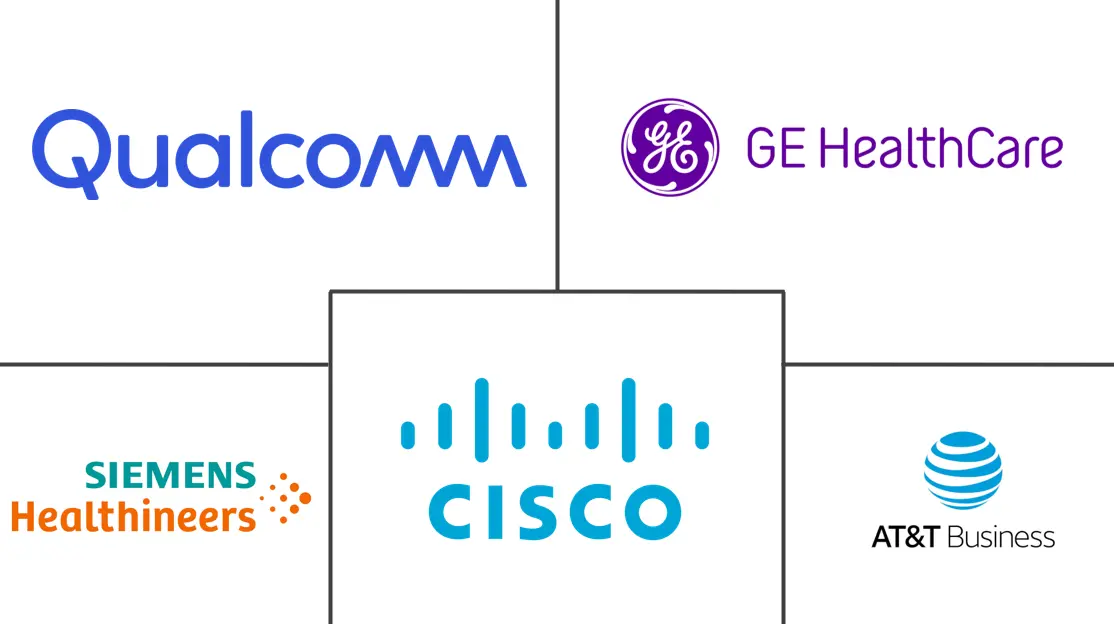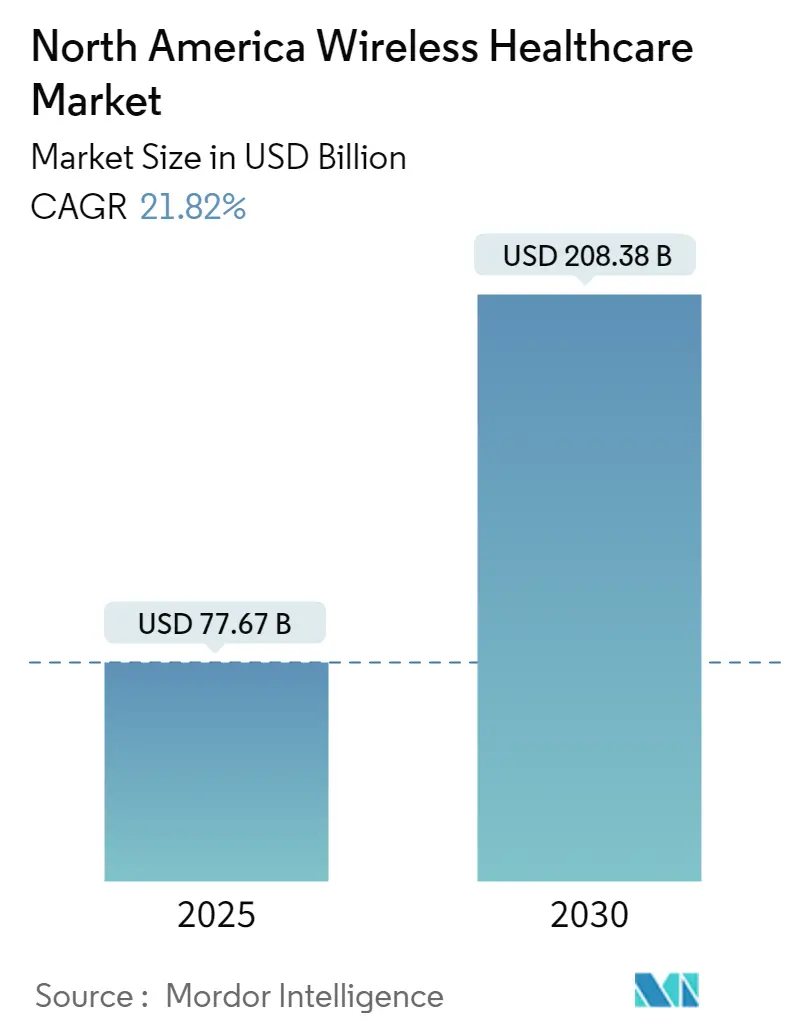
North America Wireless Healthcare Market Analysis by Mordor Intelligence
The North America Wireless Healthcare Market size is estimated at USD 77.67 billion in 2025, and is expected to reach USD 208.38 billion by 2030, at a CAGR of 21.82% during the forecast period (2025-2030).
- The demand for remote patient monitoring (RPM) solutions is anticipated to rise due to the increased prevalence of chronic diseases, the aging population, and the need to reduce healthcare costs. Wireless devices and wearables that monitor patients' essential signs and health metrics remotely can lead to the early detection of health issues and enhance patient outcomes.
- Wireless radio frequency identification (RFID) technology also allows hospitals to track the real-time location of critical equipment and the condition of the equipment. The Shands Hospital in Florida experienced a 98.8% reduction in the hours spent searching for missing items by adopting wireless technology.
- There is an increased number of services and applications associated with the Internet of Things (IoT) across different end-user industry disciplines. IoT has evolved from RFID and wireless sensor network (WSN) technologies to more advanced technology, with the integration of cloud computing, Internet services, cyber-physical systems, and interconnections between hardware and software devices. Machine learning (ML) and AI capabilities are taking their skills to the next level, especially in the current healthcare industry.
- A worldwide shortage of healthcare workers is another parameter influencing the market dynamics. For instance, the United States alone is projected to face a shortage of 124,000 physicians by 2025, which is much less than the anticipated shortages in Asian and African regions. These factors indicate the need for upgraded medical facilities and improvement in the healthcare sector, which, in turn, is expected to drive the market, as advanced and connected medical equipment is likely to experience more demand.
- The development of the wireless healthcare industry has been significantly supported by ongoing developments in wireless communication technologies, such as 5G, the Internet of Things, edge computing, and artificial intelligence (AI). These technologies can enable faster and more reliable data transmission, real-time monitoring, and advanced analytics, enhancing healthcare delivery and patient outcomes.
- However, collecting, transmitting, and storing sensitive patient data through wireless healthcare technologies might raise significant concerns about data security and patient privacy. Breaches or unauthorized access to patient information can weaken trust and hinder the adoption of wireless healthcare solutions.
North America Wireless Healthcare Market Trends and Insights
Presence of Digital Health Startups and Increased Investments in Healthcare Technology to Drive the Market Growth
- The rise of startups in the wireless healthcare domain leads to the creation of specialized solutions catering to specific medical conditions, patient demographics, and healthcare scenarios. These tailored offerings ensure that wireless healthcare technologies are designed to meet North American patients' diverse and evolving needs.
- For instance, in July 2023, Herself Health, a business that provides primary care for women over the age of 65, said that it had secured a USD 26 million Series A fundraising round. Further, in August 2023, Daybreak, a United States-based healthcare startup, announced a USD 13 million Series B funding, which Union Square Ventures is leading. The current strategy is to expand its service footprint across additional school districts nationally.
- Many startups focus on telehealth platforms and remote monitoring solutions that utilize wireless communication. These technologies enable virtual consultations, remote diagnostics, and continuous health tracking, ensuring patients receive timely care and monitoring from the comfort of their homes.
- The surge in investments in healthcare technology, particularly in the wireless healthcare sector, injects capital into startups and emerging companies. This financial support accelerates wireless healthcare innovations' research, development, and commercialization, fostering market growth.
- Moreover, as per StartUp Health, eight of the ten most significant investments in the field of digital health were made in the United States in 2022. Ultima Genomics, a US business, received USD 600 million in investment, making it the biggest deal. Such instances indicate the country's increased focus on investments in health startups, thereby contributing to the market growth.
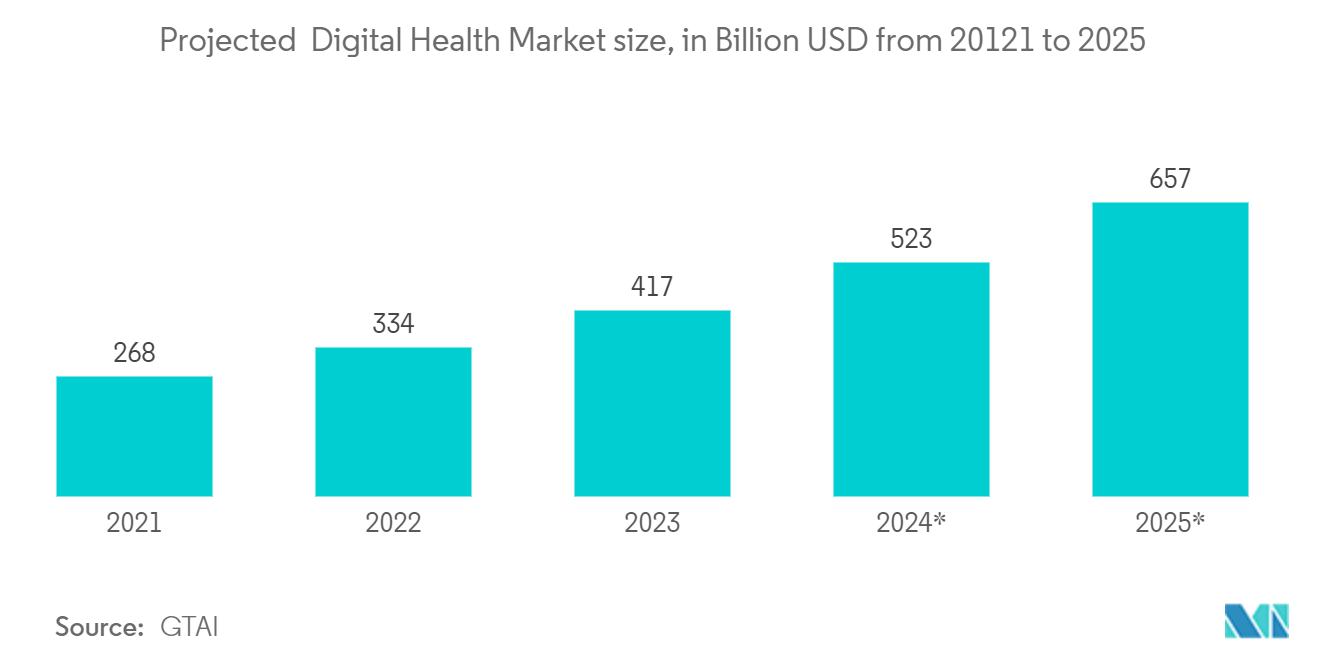
United States to Hold a Significant Market Share
- The United States is positioned to guide the region's wireless healthcare revolution with its robust healthcare infrastructure, technological expertise, and strategic investments, driving transformative changes in patient care, healthcare delivery, and overall wellness management.
- Further, the country hosts a vibrant digital health ecosystem encompassing a wide spectrum of stakeholders, including healthcare providers, technology companies, regulators, insurers, and patient advocacy groups. This collaborative environment accelerates the adoption and integration of wireless healthcare solutions.
- In addition, the United States has witnessed significant growth in telehealth and virtual care, driven by the need for remote healthcare services. Wireless technologies enable seamless telehealth consultations, remote monitoring, and digital health platforms, making the country favorable for wireless healthcare adoption.
- Moreover, according to the American Medical Association (AMA), in 2022, tele-visits or virtual visits account for a more significant adoption rate, accounting for about 80% of the respondents, owing to the increased significance of efficient and improved patient care in the country.
- Further, the United States serves as an innovation hub for wireless healthcare technologies, promoting the creation of innovative solutions that can transform patient care, diagnostics, treatment, and preventive measures.
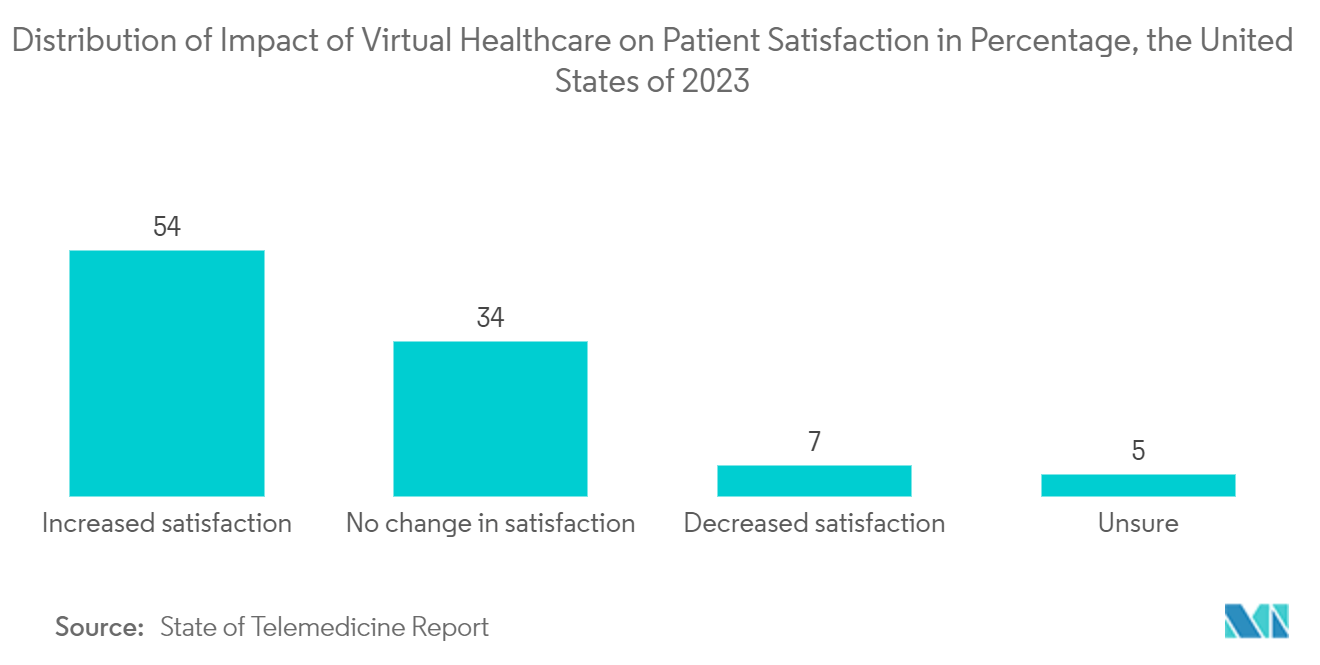
Competitive Landscape
The North American wireless healthcare market is expected to exhibit a moderate level of concentration, attributed to the presence of established global players with substantial market shares and the emergence of new entrants. Many key players are actively engaging in partnerships, collaborations, and innovative initiatives to expand their market presence within the region. Prominent companies operating in this market include GE HealthCare Technologies Inc., Siemens Healthcare GmbH, AT&T Inc., Cisco Systems, Inc., and Qualcomm Technologies, Inc., among others.
In July 2023, Siemens Healthineers announced a strategic partnership with Atrium Health to advance surgical training in the United States, marking their position as the inaugural strategic partner with IRCAD North America, a subsidiary of the renowned nonprofit healthcare organization Atrium Health. The newly established Center of Excellence for Medical Learning will leverage Siemens Healthineers' cutting-edge medical imaging technologies, participate in curriculum development, and enhance the overall educational experience for surgeons and their teams.
In February 2023, TriHealth, an integrated healthcare delivery system headquartered in Cincinnati, entered into a long-term strategic collaboration with Royal Philips, a global leader in health technology. This partnership is designed to support the TriHealth Heart & Vascular Institute situated on the Bethesda North Hospital campus and the Harold and Eugenia Thomas Comprehensive Care Center. By leveraging Philips' comprehensive cardiology solutions, TriHealth aims to expand its cardiac care offerings while delivering high-quality services and collaborating with other healthcare providers to ensure coordinated care. Additionally, this partnership will play a pivotal role in training the next generation of medical professionals.
North America Wireless Healthcare Industry Leaders
-
GE HealthCare Technologies Inc.
-
Siemens Healthcare GmbH
-
AT&T Inc.
-
Cisco Systems, Inc.
-
Qualcomm Technologies, Inc.
- *Disclaimer: Major Players sorted in no particular order
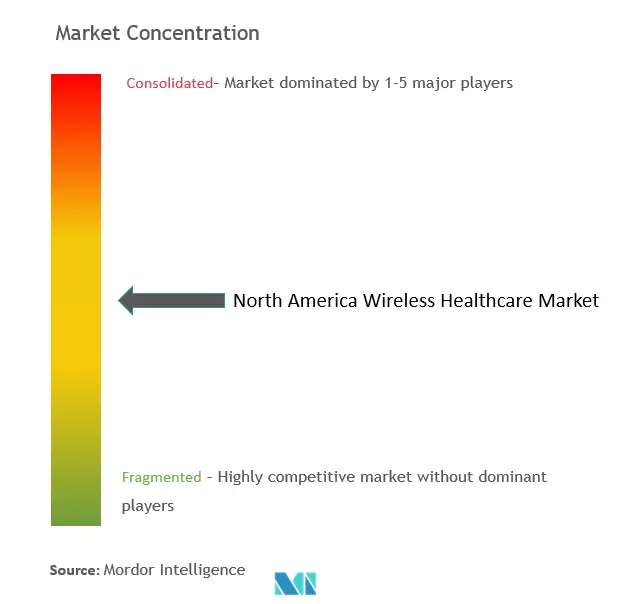
Recent Industry Developments
- June 2023: Cardinal Health, a United States-based healthcare services company, announced that it had signed an official agreement to transfer its Outcomes business to BlackRock Long Term Private Capital and GTCR portfolio firm Transaction Data Systems (TDS) in exchange for a small equity investment in the newly formed organization. The purchase is going to generate one of the largest networks of 40,000 retail, chain, and grocery pharmacies in the country, as well as a broad, integrated portfolio of pharmacy software for workflow with involvement from patients and clinical solutions designed to serve patients, pharmacies, payers, and pharmaceutical company ecosystems.
- March 2023: Atrium Health and Best Buy Health announced a partnership in creating new hospital-at-home services to improve patients' experiences of obtaining hospital-level care at home. The partnership aims to empower healthcare professionals to offer patients high-quality treatment while easing the financial and mental stresses on patients and caregivers.
North America Wireless Healthcare Market Report Scope
Wireless healthcare can integrate wireless communication technologies and devices into the healthcare industry to enable the remote monitoring, diagnosis, treatment, and management of patients' health and medical conditions.
The North America wireless healthcare market is segmented by component (hardware and software, services), application (hospitals and nursing homes, home care, and pharmaceuticals), and geography (United States, Canada).
The market sizes and forecasts are provided in terms of value in USD for all the above segments.
| Hardware |
| Software |
| Services |
| Hospitals and Nursing Homes |
| Home Care |
| Pharmaceuticals |
| United States |
| Canada |
| Component | Hardware |
| Software | |
| Services | |
| Application | Hospitals and Nursing Homes |
| Home Care | |
| Pharmaceuticals | |
| Geography | United States |
| Canada |
Key Questions Answered in the Report
How big is the North America Wireless Healthcare Market?
The North America Wireless Healthcare Market size is expected to reach USD 77.67 billion in 2025 and grow at a CAGR of 21.82% to reach USD 208.38 billion by 2030.
What is the current North America Wireless Healthcare Market size?
In 2025, the North America Wireless Healthcare Market size is expected to reach USD 77.67 billion.
Who are the key players in North America Wireless Healthcare Market?
GE HealthCare Technologies Inc., Siemens Healthcare GmbH, AT&T Inc., Cisco Systems, Inc. and Qualcomm Technologies, Inc. are the major companies operating in the North America Wireless Healthcare Market.
What years does this North America Wireless Healthcare Market cover, and what was the market size in 2024?
In 2024, the North America Wireless Healthcare Market size was estimated at USD 60.72 billion. The report covers the North America Wireless Healthcare Market historical market size for years: 2019, 2020, 2021, 2022, 2023 and 2024. The report also forecasts the North America Wireless Healthcare Market size for years: 2025, 2026, 2027, 2028, 2029 and 2030.
Page last updated on:
North America Wireless Healthcare Market Report
Statistics for the 2025 North America Wireless Healthcare market share, size and revenue growth rate, created by Mordor Intelligence™ Industry Reports. North America Wireless Healthcare analysis includes a market forecast outlook for 2025 to 2030 and historical overview. Get a sample of this industry analysis as a free report PDF download.
